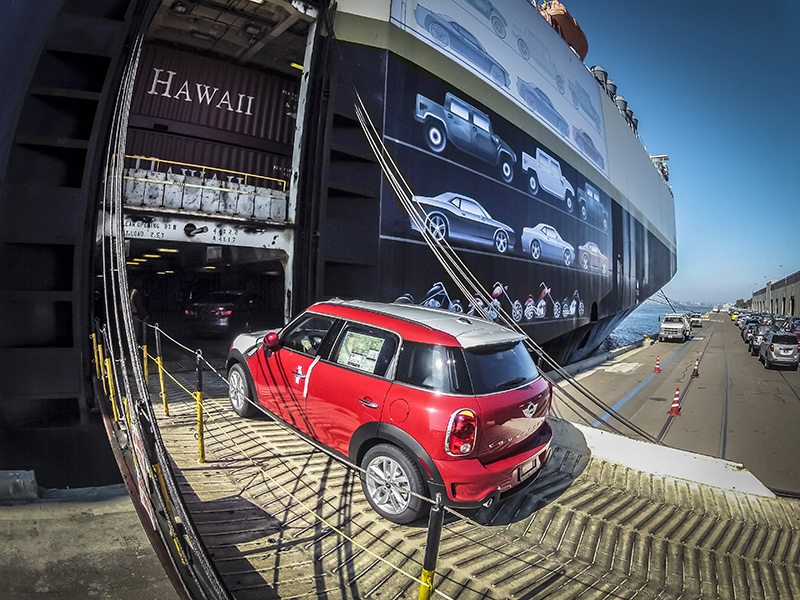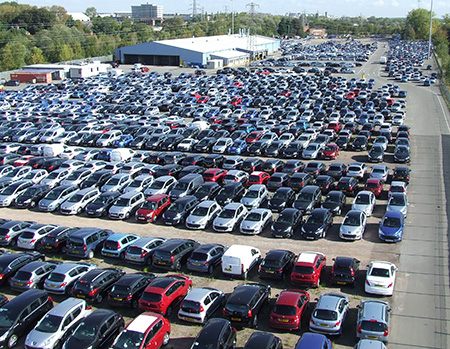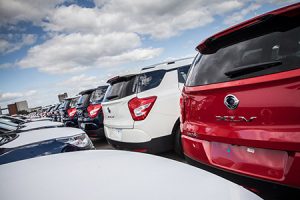Balancing the demands of high volumes and diverse products with the need for efficiency and security calls for investment and flexibility in both staffing and IT
 The growth in the US and UK vehicle industries over the last few years means more cars are being moved in and out of the ports servicing these markets. This has led to a demand for expansion at the port terminals handling imports and exports, and the development of new vehicle handling terminals at ports that did not previously handle automotive traffic.
The growth in the US and UK vehicle industries over the last few years means more cars are being moved in and out of the ports servicing these markets. This has led to a demand for expansion at the port terminals handling imports and exports, and the development of new vehicle handling terminals at ports that did not previously handle automotive traffic.
The growth in the movement of vehicles has also increased the need in many cases for inland storage, whether at rail yards or distribution compounds.
In this story...
If you’re going to San Francisco…When drawing up priorities for these developments, service providers on both sides of the Atlantic are in agreement that the quality of infrastructure is critical. While new developments at the major established vehicle ports are happening with increasing regularity, it is also important to look at new developments at ports breaking into the sector for the first time.
According to Pasha Automotive Services, which has a number of operations on the US West Coast, adequate infrastructure has to be in place at the ports as a priority.
“First you have to have operable berths and enough real estate for clients to be able to import or export cars at your facility,” says John Pasha, senior vice-president. “Our business model is full service on terminal, so we need a wash facility, assembly and repair shops all in close proximity. We need storage space to allow us to store vehicles until their inland transportation is available.”

[sta_anchor id="1"]In August this year the company started new vehicle and breakbulk operations at the port of San Francisco on its 70-acre (28-hectare) cargo terminal following the signing of a 15-year agreement with the port. This new business supports Pasha’s Hawaii ro-ro service, which also calls from other west coast ports, and is a good of example of the demand on an operator to balance volume handling and diverse products.
In June, Pasha also signed a lease with Tradepoint Atlantic at Sparrow Point near the port of Baltimore – located on part of the site of the massive former Bethlehem Steel plant that is being redeveloped – to launch vehicle processing operations for Fiat Chrysler Automobiles.
The choice of San Francisco, which is not a major vehicle handling port, is down to the fact that Pier 80, where the terminal is based, has turnkey infrastructure to handle a vast array of cargoes.
“Our Hawaii service carries buses, train cars, yachts, military helicopters and vehicles,” says John Pasha. “Anything that rolls, and even pipe and other breakbulk that can be moved by trailer to the [Hawaiian] Islands."
Pasha also has ambitions for the port beyond transhipment to Hawaii. An underused terminal in the past, the company expects Pier 80 to handle around 96 ro-ro vessels a year with a throughput of 150,000 vehicles as operations ramp up, including to serve northern California directly as opposed to trucking vehicles from further south.
The big and the smallInfrastructure for vehicle storage, and its maintenance, is also a priority for operators in the UK, where record sales levels have put pressure on ports to expand. This was seen most recently in the significant investment Associated British Ports (ABP) made at the port of Southampton in September.
Southampton, the UK’s busiest single vehicle-handling port, processed 900,000 vehicles last year, including 520,000 for export. So far, worries over the UK’s vote for Brexit have not dampened demand or diverted investment plans. ABP has announced a phased £50m ($66m) investment in its vehicle-handling facilities at the port (it has already invested £32m over the past five years to support vehicle exports).
The first half of that will go into two new multi-storey vehicle handling facilities (structures that barely exist in North America at ports) that together will be able to store 7,600 vehicles en route to export markets. The second part of the investment will add another two facilities and taken altogether the port of Southampton will add 15,000 spaces to its vehicle storage capacity. It will take the total storage capacity at the port to 55,000 across nine vehicle handling facilities.
 Gefco’s PDI facility at Corby, UK, stores and processes vehicles for rental and leasing companies as well as PSA Group
Gefco’s PDI facility at Corby, UK, stores and processes vehicles for rental and leasing companies as well as PSA Group[sta_anchor id="2"]However, not all yard investment needs to be on such a grand scale. This past June, at the port of Portbury near Bristol, the UK division of South Korea’s SsangYong Motor (SYMUK) took over control and management of its vehicle importation and reception base. The carmaker has also created a vehicle preparation centre at the port following an investment of £150,000 ($214,500), which includes a five-ramp workshop, 14 accessory bays and parts storage. The compound accommodates 1,400 vehicles, with the potential to expand this to 1,800. The move followed a study and tender process carried out with automotive logistics consultancy Alljoinedup.
Tom Jacobson, managing consultant at Alljoinedup, explains that, as a smaller brand, Ssangyong’s considerations about where to develop handling operations are based on where shipping lines are already calling. That then entails carving out space at a port already busy with other customers to accommodate current volumes, but with a view to growth. Managing this depends on the contract with the port. Ssangyong has a lease agreement with Portbury for a minimum period that has allowed it to build its processing centre, including a pre-delivery inspection (PDI) facility.
“What we do is pay the port for the storage, so rather than a fee per day we actually have an agreement for a plot of land and then on top of that we have the other facilities that we lease ourselves, plus the IT and that sort of thing,” says Jacobson.
Looking for landJust because volumes are relatively small doesn’t mean a yard operation doesn’t need external space. Ssangyong’s own fluctuations have led it to lease overspill space in yards at nearby Avonmouth on a spot basis. The OEM’s throughput this year will be around 5,500 units, based roughly on twice-monthly deliveries on WWL vessels, which Jacobsen predicts will grow to 7,000 in 2017 and 10,000 by 2018, with a view to doubling that figure in future.
“The infrastructure has to be in place to do that and we haven’t got the facilities in the port at the moment to cope with 20,000,” he says.
Jacobson says SYMUK is currently looking at land available at Portbury for future development. “Space has been a problem because potentially you could get to a situation where volume throughput doesn’t change but the sales end does, so you end up with more units in the UK until the factory production changes as a consequence,” he says. “At the moment it doesn’t look like it, but who knows what is going to happen?
“We will have a clearer idea after September to see what the market is doing. Our own sales seem to be holding up well and will do if it continues at the same level we’ve been going.”
In the meantime, he adds, the close relationship with Portbury means that it has been very good at finding SYMUK space when required, but better management of space through greater visibility is another priority. “Ease of access to units, visibility and preplanning where units will go on arrival balanced with those going out – that is what we are looking to do; it is a balancing act,” says Jacobson.
[sta_anchor id="3"]Inland yard managementWhile port and plant yards handle the largest volume of vehicles, inland terminals also play important roles in the supply chain, both for new vehicle distribution and remarketing.
In the UK, transport and logistics provider Gefco has four PDI facilities through which it processes more than 51,500 vehicles a year, as well as handling warranty, smart repair and bodyshop services. One of those facilities, at Corby in the Midlands, stores and processes vehicles for its previous majority owner, PSA Group, but also across major rental and leasing companies.
Corby does around 20,000 pre-delivery inspections per year and about 12,000 vehicle de-fleets. It also carries out ‘vehicle transformation’ for 4,000 vehicles, which includes the preparation of vehicles for specific uses, such as adding livery for postal or police vehicles.
Gefco has invested significantly in technology and equipment to manage complexity at the yard.
“All our vehicles are managed with barcodes and electronic scanners,” explains Greg McDonald, centre manager for Corby. “The last thing I want, for instance, is to replace the engine in a particular vehicle when something else was what was needed.”
 While Ssanyong’s operations at Portbury remain heavily reliant on manual processes, the company is assessing software solutions to improve tracking
While Ssanyong’s operations at Portbury remain heavily reliant on manual processes, the company is assessing software solutions to improve trackingA Gefco proprietary system identifies and tracks vehicles through inspection or repair processes. The system provides information on when vehicles are finished and where they should be parked. “The system will tell an operator where there is a space, so he takes the car there and then it tells him the nearest car to bring back,” adds McDonald. “We call it ‘twinning’: it matches the nearest space to the next car needed.”
Corby has storage space for 4,800 vehicles and can handle 150-200 PDIs a day, though the footprint of its workshop is relatively small compared to the overall size of the compound, which is 43 acres. Gefco’s portside operation at Sheerness, by contrast, covers 85 acres and stores up to 20,000 vehicles.
Gefco also uses an IT system called eSky, a vehicle repair guidance manual, to ensure its staff are following the correct repair procedure specified by the different carmakers.
“Whatever car comes in, you have to go to eSky, which all the manufacturers feed into,” says McDonald. “It tells you the method of repair and you have to follow that. You can’t just decide you are going to fix it one way, as it could be dangerous. We have to have the right systems, training and accreditations, and the more brands you process, the more of that you need.”
A flexible workforceMost yards face peaks and troughs in vehicle volume. For Corby, this is complicated by characteristics of the rental and leasing market. For example, the centre gets little advance notice ahead of peak periods since, according to McDonald, the contracted finish date between rental companies and a manufacturer is open to last-minute change. Likewise, rental companies may decide to extend contracts.
These hard-to-predict peaks complicate setting staff levels. The decision to extend a contract at the last minute could mean staff hanging around with nothing to do. A sudden recall on a vehicle for safety purposes could also lead to crowded yards. The answer is having a scalable workforce.
“If we get a recall programme on a vehicle we deal with, we have to act accordingly,” says McDonald. “First we have to tell all of the customers, ‘sorry you cannot have your car for this amount of time’, and we have to do the recalls and repair. That can go anywhere from ten minutes per job to a full engine replacement, which basically takes a day. Then we scale up to do it, so we talk to our suppliers and say we need ‘X’ amount more technicians for three weeks.”
"[eSky] tells you the method of repair and you have to follow that. You can’t just decide you are going to fix it one way, as it could be dangerous. We have to have the right systems, training and accreditations, and the more brands you process, the more of that you need." - Greg McDonald, Gefco
By contrast the centre also handles heavy repairs for in-life rental cars, which means comprehensive work on one vehicle. However, this is steadier, according to McDonald. “Work like that allows you to retain core staff so you are not going down to nothing,” he says. “So it’s a mix of keeping key staff on a linear pattern and scaling up and down around that.”
Finding the right technologyInvestment in IT is central to many yard operators and carmakers at their terminals. However, it is not always feasible to invest in the most advanced systems or equipment.
At Ssangyong in the UK, for example, current yard operations remain “very manual”, according to Jacobson, but he suggests that new technology will support the carmaker in reaching its volume ambitions for the UK market.
“We know the layout of the yard but it is about managing it more effectively through some systems-based application or RFID, or 4G. [It is] about being able to identify spaces within the yard before the vehicles arrive and put them there, and also pull them from there.”
 Jacobson says the company is, however, now looking actively at yard management software providers for improvements and the ability to track the vehicles from arrival on the vessels to when they go out through the yards.
Jacobson says the company is, however, now looking actively at yard management software providers for improvements and the ability to track the vehicles from arrival on the vessels to when they go out through the yards.
“We have managed to do that in the workshop with our existing IT service provider but we are looking to do that in the yard as well,” he says. “We might have to bring an additional software supplier in to provide that. We have identified the need, it is now a question of building the business case around a profitability model – the investment against what the return is.”
Yard management technology is also something on which Pasha is focused, though its systems are all proprietary and supported by its dedicated team in San Rafael, California.
“Pasha’s software platform is the source of data analytics that provide business insight and drive improvements in our operations and customer experience,” says David Beckerman, senior vice-president and chief information officer. “We are also committed to investing in EDI and integration capabilities to simplify and standardise our customer electronic interface needs.”
John Pasha also thinks security may become a greater concern, but it is also an area where technology can help. He points out that large storage yards are often in industrial areas where crime rates are high, so high-resolution infrared cameras and alarmed geofences can be very effective.
However, adding such systems for advanced yard management and security requires both investment and qualified staff to manage them – resources that are increasingly in short supply.



































